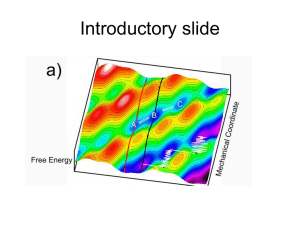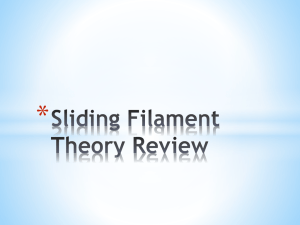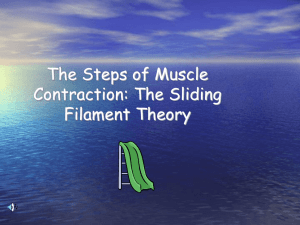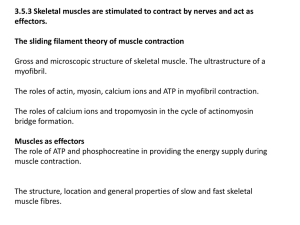Crossbridge mechanics
advertisement
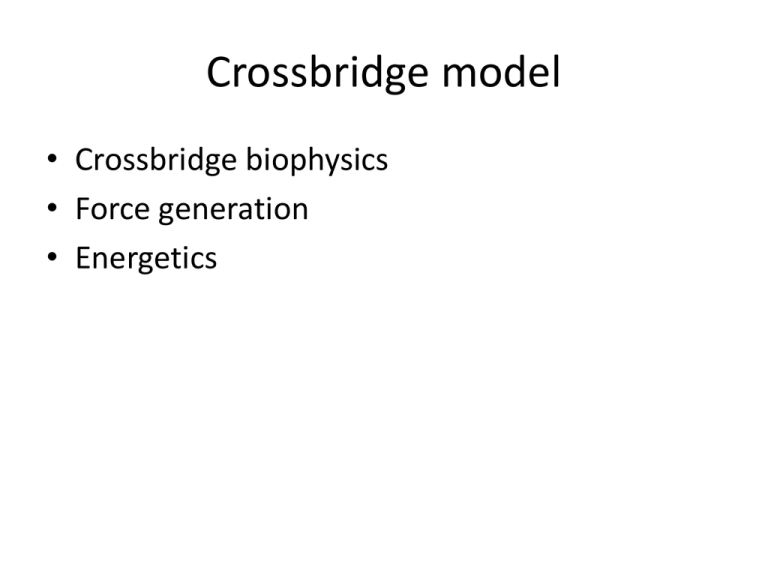
Crossbridge model • Crossbridge biophysics • Force generation • Energetics Crossbridge Cycle ATP ADP Shape change Pi Shape change Animation: Graham Johnson & Ron Vale Myosin physics S-1 Fragment • Globular head Actin Binding – Actin binding – ATP binding • Filamentous neck Hinge ATP cleft – Flexible – Light chain binding • Filamentous tail – Dimerization – Oligomerization Native Myosin Neck Laser Trap • Photon momentum = E/c • Refraction changes momentum • 3D Position control Measuring myosin steps • Compliant traps • Low ATP • Record position “Step” Position data: Brownian Motion Many steps: Actin-myosin chemical scheme • • • • • State/compartment model Actin-myosin bound/unbound ATP bound/unbound ATP/ADP+Pi Hidden states Crossbridge Cycle • Actin catalyzes Pi release • ATP catalyzes A release P AMDP First cycle: M MT D AMD AM A M T D P MDP T Repeatable: T P Actin Myosin ATP ADP Pi D AM AMT AMDP AMD AM MT MT MDP MD M T Shape Changes P D Lymn & Taylor 1971 Quenched-flow chemistry • Reactions in moving medium – Steady-state relation btw time and distance – Measure very fast reactions Reagent 1 Reagent 2 Mix ATPPi by o Actin-myosin • Myosin alone Quench o AM + ATPAMADP + Pi • M+ATP MADP + Pi After an initial burst, actin accelerates reaction Initial ATP hydrolysis independent of actin, sustained Rx catalyzed by actin Actin-myosin dissociated by ATP • Stopped-flow measurements • Light scattering by A-M filaments Reagent 1 – ie, turbidity Mix Turbidity T AM AMT MT MT Reagent 2 Detector AM + ATP AQuench + M●ATP Lymn & Taylor (1971) Phosphate release catalyzed by actin Add actin • Pi release by fluorescence • More actinfaster release 75 s-1 T AM P AMT AMDP AMD MT MDP MD 1-2 s-1 P Heeley & al (2002) Chemical summary • Myosin is an ATPase with large shape differences – M-MATP – MATP-MADP – MADP-M • Filamentous actin facilitates Pi release • ATP facilitates f-actin release Relate chemistry to force • AF Huxley 1957 Crossbridge model • Two states: myosin attached or myosin not attached • Force results from elasticity of individual crossbridges • Myosin interacts with actin at discrete sites • Attachment and detachment rates are position dependent Cartoon: capture the minimal process • Modeling crossbridge attachment – Imagine Pi release & power stroke instantaneous – A + M AM + Force with rate constant f – AM A + M●ATP with rate constant g • Think about behavior of single crossbridge • Imagine many crossbridges spanning all configs Thick filament Rigor State x=0 Thin filament Max Attachment length x=h Mathematics • Two states: myosin attached (n) or myosin not attached (1-n) dn (1 n ) f ( x ) ng ( x ) dt dn f ( x) n f ( x) g ( x) dt • Force results from elasticity of individual crossbridges – Individual: Fb=kx – All: F k x n dx Mathematical features • First order: exponential • Steady state – dn/dt 0 dn – dt f ( x ) n f ( x ) g ( x ) – n(x) = f/(f+g) Crossbridge attachment rate • Relate crossbridge physics to x • Energy released by binding • Energy required for deformation “Energy”2.0 1.5 f Binding 1.0 0.5 Deformation 0.0 -2.0 -1.5 -1.0 -0.5 0 0.5 1.0 1.5 2.0 -0.5 Position (X) -1.0 -1.5 -2.0 Prohibit attachment x>h An unbound myosin is positioned just at “x=1” and can drop onto actin without any bending f1 0.0 0 h Position (X) Crossbridge detachment rate • Release deformation energy • Release conformation energy – Discrete change x<0 Binding 2.0 “Energy” Deformation g g3 1.5 1.0 0.5 0.0 -2.0 -1.5 -1.0 -0.5 0 0.5 1.0 1.5 2.0 -0.5 Position g1 (X) -1.0 -1.5 -2.0 A bound myosin is positioned just at “x=0” and any displacement requires bending 0.0 0 h Position (X) Steady state crossbridge attachment • n(x) = f/(f+g) • x<0 ; x>h n=0 – 0<x<h n=f1/(f1+g1) • Force=∫k∙n∙xdx – k(f1/(f1+g1))(h2/2) – Crossbridge stiffness – Ratio of f:g f1/(f1+g1) g3 f1 g1 0.0 0 h Position (X) Crossbridge behavior during shortening • Since n=n(x), dn/dt depends on dx/dt dn n x n v dt x t x v n f ( x ) f ( x ) g ( x ) n x • Crossbridge moving in from x>>h – No chance to attach until x=h – High probability to attach, but limited time – Probability to attach decreases to x=0, but time rises – Rapid detachment x<0 Crossbridge distribution • V=0 • V= Vmax/3 – Uniform attachment – Mean x = h/2 – No saturation – Mean x 1 0.8 0.8 0.6 0.6 n 0.4 0.4 0.2 0.2 0 x>0force > 0 n 1 0 -0.01 0 x 0.01 -0.01 0 x 0.01 x>0force < 0 These crossbridges resist shortening Dynamic response Transition to lengthening • Fully attached crossbridges get over-stretched • Unattached crossbridges dragged in from left Faster lengthening Transition to shortening • Fully attached crossbridged get compressed • Unbound crossbridges dragged in from right Faster shortening Damping without viscosity • Qualitative (and quantitative) results of crossbridge and Hill models similar – Even the math: dL/dt = F/b - k/b L – dn/dt = f - (f+g)n • Mechanisms behind the models are very different – Crossbridge predicts/validated by biochemistry Energy prediction • Energy liberation – Power from P*v – Heat from dn/dt: increased by shortening Shortening Vopt 1 0.8 Accelerated release n 0.6 Accelerated binding 0.4 0.2 0 -0.01 0 x 0.01 Total energy rate – Hill’s data o Huxley’s model Issues • Fast length changes – < 2 ms (500 s-1) – Violates “one process” assumption T0 T2 100 ms T1 • Lengthening – Too many very long x-bridges • Residual force enhancement Model • Double-hyperbolic F-V Data Summary • Crossbridge cycle: – AM+TA+MTA+MDPAMDPAMDAM • Attachment of elastic crossbridges explains force-velocity relationship – Reduced attachment during shortening – Shorter length of attachment • Higher state models fit better
